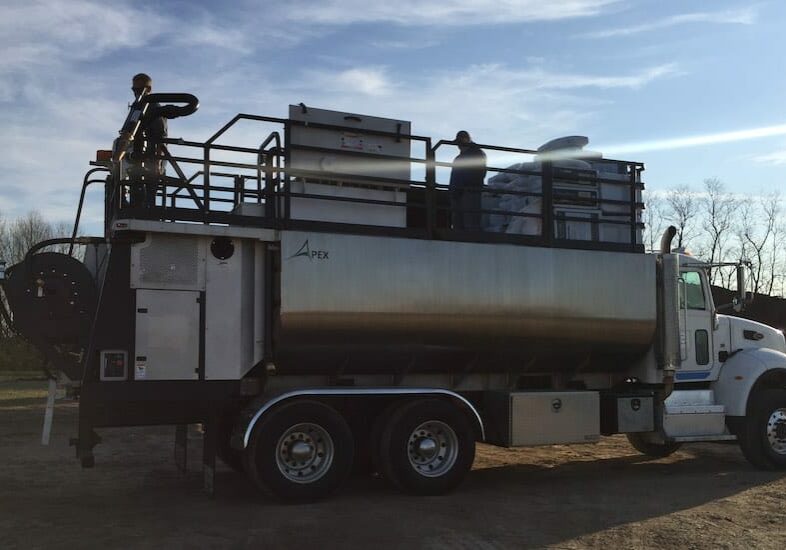Hydroseeder Trucks, Skids or Trailers – Which is Right for You?

Share this article!
Hydroseeders can improve convenience and efficiency for many commercial landscaping projects. Choosing the right hydroseeder configuration, and the right size hydroseeder, for the job helps ensure returns on a hydroseeding equipment investment.
Deciding between hydroseeder models can seem like a daunting task, but once you understand the different types of hydroseeders and what they’re primarily used for, you can make an informed choice for your business.
The Different Types of Hydroseeders
Hydroseeders are generally available in 3 different types, each suited to a specific type of job. The way a hydroseeder is configured can bring flexibility or power to a job site depending on what’s required, and some can offer a combination of both.
Skid Hydroseeders
Skid hydroseeders are hydroseeders that are contained on a platform and can be transported in a truck or mounted to a trailer. Designed to be lifted by a forklift or crane, they can be placed in the bed of a truck or on an appropriate trailer, and potentially moved if necessary.
Skid hydroseeders are available in a variety of sizes and capacities, and can be a versatile solution for everything from entry-level hydroseeders to experienced, commercial landscapers.
Trailer Hydroseeders
Trailer hydroseeders are hydroseeders that are built into a trailer system that can be towed behind a truck. Trailer hydroseeders are built to be rugged and dependable, and like skid mounted systems, are available in a variety of models to accommodate different types of projects, from residential lawns up to commercial highway projects and large athletic fields.
Trailer hydroseeders are available in two tow variations:
Straight Tow Trailer
The straight tow trailer system for hydroseeders allows the hydroseeder to be pulled behind any truck or vehicle with the required tow capacity. Functioning like any other type of trailer, straight tow hydroseed trailers can be towed to job sites and used wherever they’re needed as far as access allows.
Gooseneck Tow Trailer
Gooseneck tow trailers can often offer more flexibility and capacity for hydroseeders since gooseneck options can typically support more weight than their straight tow counterparts. When hydroseeding large areas, or areas that may be hard to access, a gooseneck trailer can be a great choice to reduce the need to refill consumables or go back and forth between areas since they can typically haul larger loads of consumables.
Goosenecks also have a reputation as being more stable than straight tow trailers, so for jobs that require off-road access or are more rugged in general, the gooseneck can add more functionality and reliability for hydroseeding.
Hydroseeder Trucks (aka Hydroseeders)
For our purposes, a hydroseed truck is defined as a self-contained hydroseed unit that’s skid mounted to a semi or semi-like chassis. These kinds of hydroseed trucks are complete units in and of themselves, and can function and drive more like a traditional truck or heavy rig. Because the hydroseeding components of a hydroseed truck are mounted directly onto the vehicle, this can be an appealing option for many larger hydroseeding jobs.
Truck hydroseeders tend to be rugged, which can make them great for projects in areas where other vehicles, and especially trailers, may experience issues. They can also accommodate heavy loads of consumables, which can make them more efficient for larger jobs.
It’s also important to note that hydroseeder trucks have a high ground clearance, meaning you’ll need to operate the seeder itself from the truck. If you’re not comfortable or able to deal with the logistics, a trailer makes a much more accessible option, especially for smaller projects.
Considerations for Hydroseeder Trucks, Trailers or Skids
Knowing the different options for hydroseeding machinery is a great start to deciding which configuration might be right for you. The next step is to evaluate the strengths and weaknesses of each, and weigh those against the types of hydroseeding jobs you’re most likely to be taking on.
Job Size
The size of a hydroseeding site is a key consideration, because this will dictate how much mulch, fertilizer, seeds, and other consumables you’ll need to use to properly seed the area. Each type of hydroseeder can seed just about any size project, but the consideration is in the time it takes to complete.
Smaller hydroseeders can seed large areas, for example, but you’ll need to stop to refill consumables, and if water access isn’t close by, this can mean driving to a water source to refill in between applications which can add significant time to a project.
Larger hydroseeders, like hydroseed trucks, skid mounts, and some gooseneck trailers, can accommodate heavy loads of consumables, which can make application much quicker.
Job Location
Considering where hydroseeding projects will take place is also important since it will help you narrow down the type of equipment that will likely be the most economical choice. If job sites are likely to be in construction zones where terrain is unpredictable and rugged, a hydroseed truck or gooseneck can often provide the handling required.
However, if jobs are likely to be more residential or commercial in nature, where paved roads or access points are fairly stable, a straight tow trailer may be more than enough to get the job done.
Other Equipment and Supply Needs
Considering project materials can also help you determine what type of hydroseed equipment may fit your needs. Do you anticipate taking on projects that will require a lot of ground leveling and preparation? What about jobs in remote areas where water access is unpredictable?
If the answer to either of these is yes, a configuration like a hydroseed truck with a tow may allow you the greatest amount of flexibility to get to job sites and complete jobs quickly. If you need to use a ground preparation attachment to get the site ready, you can generally tow these behind a hydroseed rig, or arrange for a separate trailer with your needed equipment to be on site.
With a nurse tow package on a hydroseed truck, for example, you can access rugged locations and have additional water or consumables on hand to mix on site, reducing unnecessary trips to and from the site.
Budget
Finally, your budget for hydroseed equipment can determine what type of hydroseed option is feasible.
Small-capacity trailer skid mounts can be relatively affordable, ranging from around $8,000 up to $20,000. If you anticipate smaller jobs, these choices can often pay for themselves in as little as a year, depending on the number and size of the projects you take on.
Large or commercial-size projects often require commercial-sized solutions for the most effective and efficient results. With the larger investment – often in the neighborhood of $90,000+ — depending on the equipment, it’s best to be aware of how many projects you’ll need to complete, and in what time period, to recoup your investment.
Takeaway
In general, a hydroseeder of almost any variety can complete any number of seeding projects. The question is how quickly, and with how much effort, you can get the project done. Working out how many people you have available for seeding projects, as well as how many, and how large those projects are likely to be, should give you a sense of what hydroseeding equipment makes the most sense for your application. For more information about hydroseeding trucks, trailers, or skids, contact our professionals at Apex.
